A visit to Rushall Community Garden
In October 2023, Ann Stanley visited Rushall Community Garden in Fitzroy North.
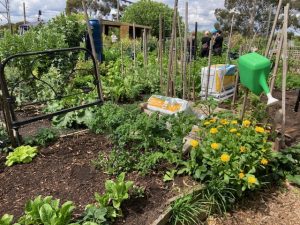 Rushall Community Garden is part of the North Fitzroy Community Gardens Group (NFCGG), a non-profit organisation that formed in 1997, with the aim of establishing a community garden in North Fitzroy. The NFCGG has both individual allotments and space for communal gardening projects.
Rushall Community Garden is part of the North Fitzroy Community Gardens Group (NFCGG), a non-profit organisation that formed in 1997, with the aim of establishing a community garden in North Fitzroy. The NFCGG has both individual allotments and space for communal gardening projects.
It was a pleasure to visit Rushall Community Garden on their annual Open Day so there was food, drink, seedlings, preserves and fresh produce for sale. The mulberry tree, laden with fruit, in the public space in the approach to the gate gives the garden a sense of generosity that was confirmed by the people I met behind the fence.
Rushall Community Garden is well planned. The spring crop is lush and beautiful in irregular-shaped beds with close plantings of healthy silverbeet, fennel,  asparagus and every other spring thing. There is a large water-tank, a tidy composting system, thriving worm farms, and a propagation area, all separated with neat paths.
asparagus and every other spring thing. There is a large water-tank, a tidy composting system, thriving worm farms, and a propagation area, all separated with neat paths.
Lyn, one of the gardeners, told me how it worked and this gave me a sense of how the garden is managed. Lyn put herself on the waiting list several years ago and spent the long wait volunteering in working bees and in the public areas just outside the fence until, eventually, she had the opportunity to share a plot with another member. That’s when her own food growing started. Seeing plants grow from seed into food has given her much joy ever since.
There are communal plots as well as individual ones and Lyn explains that taking from these works on an honour system, which is the case also for taking fruit from the fruit trees. 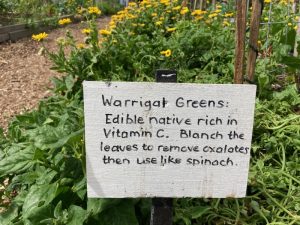 “People help themselves. Any surplus is put outside the fence for passers-by from the local community to take.”
“People help themselves. Any surplus is put outside the fence for passers-by from the local community to take.”
She explains that the Committee oversees the buying in of products such as mushroom compost and manure, which are then made available for use. This ensures that the garden stays organic and “there is some control over what comes in.” The worm castings are similarly distributed once they are ready for members to use.
“A lot of the structure of the gardens, as well as the guidelines for the management of them, were established early.” One guideline is that priority is given to applicants from the nearby public 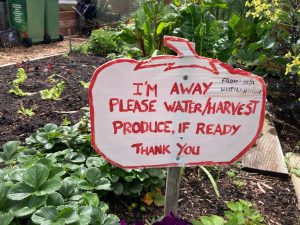 housing who would like to join.
housing who would like to join.
Lyn explained that members can join smaller groups to take charge of different parts of the garden management. There is the compost group, the seed-raising group, the group that looks after the communal beds and the ‘wormies’ group, in charge of the worm farm. Members can be part of these groups whether or not they have a plot themselves.
One member, Ryan, currently works full-time and does not have time to manage a plot but is happy to help out with anything that needs to be done, like helping to erect canopies such as the one we chatted beneath. “Everyone pitches in to help. Today I’ve also been helping with the contactless payments for the produce we have for sale today. It’s better for me to just contribute here and there.”
Farewell to Plot 21 (by Jane Miller)
[Jane Miller was at the community garden at the outset “when it was bare dirt with a cyclone fence around it.” She had a large plot, fell in love with it, and when she had to give it up wrote the story of her relationship with the plot and what it meant to her. She gave me permission to print her story here. I have edited it a little. The photos on the right were taken by Jane.]
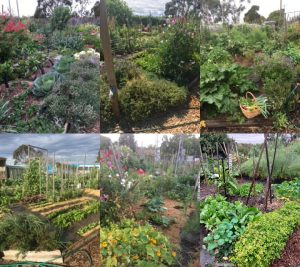 I was an original plot holder at Rushall, when it was just dirt. People were allocated original plots by numbers drawn from a hat, and I got Plot 21 – a fabulous big plot in the heart of the garden. My neighbouring three plots and I initially ignored boundaries and our four large plots were communal – we were ‘gardeners without borders’. However, that didn’t last and those other big plots were divided over time into smaller plots.
I was an original plot holder at Rushall, when it was just dirt. People were allocated original plots by numbers drawn from a hat, and I got Plot 21 – a fabulous big plot in the heart of the garden. My neighbouring three plots and I initially ignored boundaries and our four large plots were communal – we were ‘gardeners without borders’. However, that didn’t last and those other big plots were divided over time into smaller plots.
I had no garden at home when I lived in North Fitzroy, and losing myself among vegetables, flowers and compost was both grounding and satisfying. Dear friendships and acquaintances were made and developed over time. Though sometimes people suddenly disappeared and I stumbled on news of what happened.
I recently relinquished my plot as I’ve moved to Brunswick. I will stay a member for the time being.
When I left Plot 21, in the thick of house moving, I plundered my plot and successfully transplanted asparagus and rhubarb. It looked like a bomb site after. I do apologise to you newcomers. (I was not sorry to see the last of that bloody onion weed.)
I have wonderful memories, and it already feels very different to now be a plot-less garden member. I feel strange about quietly slipping away which is why I’m writing this, and wonder if notes of comings and goings might help us follow what happens when others arrive and leave.
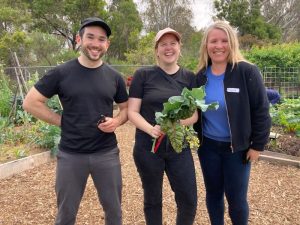 Michelle Edwards and Kathy Chambers are the current convenors of Rushall and Michelle explained, “There’s lots of ways of being involved. We have a committee of 10-12 people and each one of the committee members with also take care of one part of management of the garden. With people engaging and involved, we seem to manage to keep on top of everything. We have an AGM where issues can be raised, discussed and voted on if necessary. We are an incorporated organisation so we do follow the guidelines to make sure we are doing all the right things.”
Michelle Edwards and Kathy Chambers are the current convenors of Rushall and Michelle explained, “There’s lots of ways of being involved. We have a committee of 10-12 people and each one of the committee members with also take care of one part of management of the garden. With people engaging and involved, we seem to manage to keep on top of everything. We have an AGM where issues can be raised, discussed and voted on if necessary. We are an incorporated organisation so we do follow the guidelines to make sure we are doing all the right things.”
Michelle, says that co-convenor Kathy has valuable expertise in this area. “Kathy is very good with legislation. She was also a very early member so has 16 years of experience of the garden. We have a lot of members who have been here for more that a decade which is terrific wealth. They know the history and how the garden was established.”
While acknowledging that some compromises have had to made because the garden is in an urban environment, Michelle says, “There is so much to be joyful about. We’ve got lots of insect life, lots of bird-life. It’s a nice little pocket away from the urban world. To come up here with the open sky, without the big buildings around you, is just amazing.”
